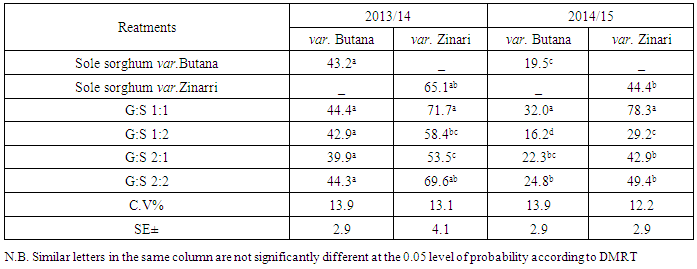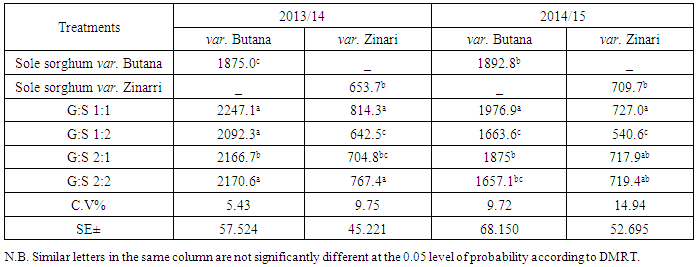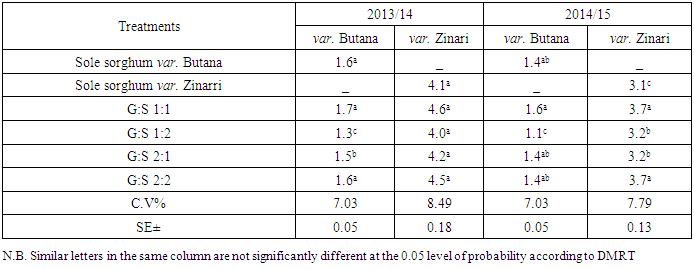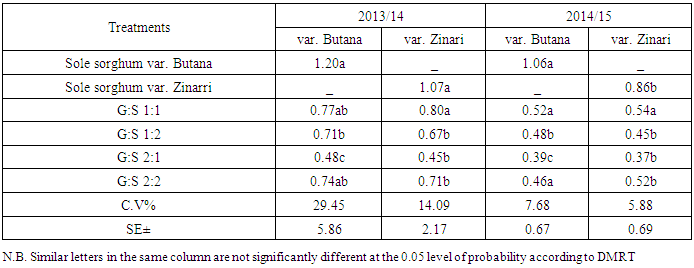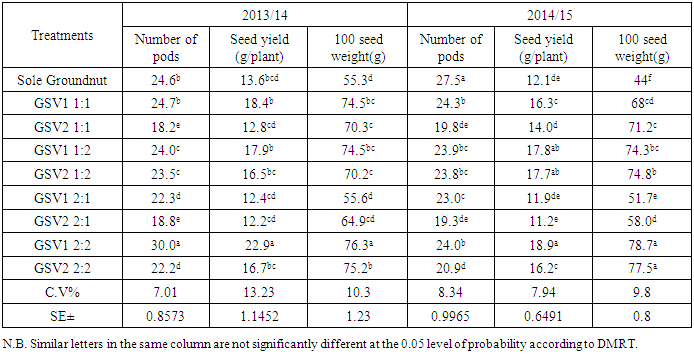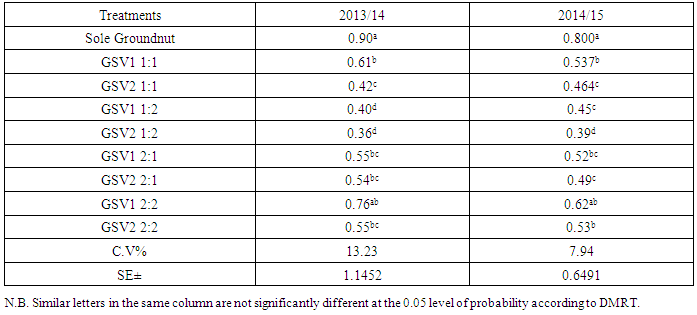-
Paper Information
- Paper Submission
-
Journal Information
- About This Journal
- Editorial Board
- Current Issue
- Archive
- Author Guidelines
- Contact Us
International Journal of Agriculture and Forestry
p-ISSN: 2165-882X e-ISSN: 2165-8846
2018; 8(5): 171-175
doi:10.5923/j.ijaf.20180805.01

Agronomic Evaluation of Groundnut and Two Varieties of Grain Sorghum Intercropped at Different Spatial Arrangements
Nagla N. Suleman1, Ahmed M. El Naim1, Mahmoud F. Ahmed2
1Department of Crop Science, Faculty of Natural Resources and Environmental Studies, University of Kordofan, Elobeid, Sudan
2Department of Agronomy, Faculty of Agriculture, University of Khartoum, Sudan
Correspondence to: Ahmed M. El Naim, Department of Crop Science, Faculty of Natural Resources and Environmental Studies, University of Kordofan, Elobeid, Sudan.
| Email: |  |
Copyright © 2018 The Author(s). Published by Scientific & Academic Publishing.
This work is licensed under the Creative Commons Attribution International License (CC BY).
http://creativecommons.org/licenses/by/4.0/

A field experiment was conducted during two consecutive seasons (2013/14 and 2014/2015) at Sheikan Locality, North Kordofan State, Sudan, to investigate the effects of intercropping groundnut with two varieties of sorghum on yield and yield components. The experiment consisted of eleven treatments: three sole crop of groundnut, a local sorghum variety (Zinari) and an improved sorghum variety (Butana) and eight spatial arrangements of 1:1, 1:2, 2:1 and 2:2 rows of groundnut with each of the local or improved sorghum varieties. Treatments were arranged in a randomized complete block design with four replications. The results revealed that the intercropping affected most of the characteristics studied. The treatment 2:2 had the highest number of pods per plant, highest seed weight, 100 seed weight for groundnut. The highest Panicle weight, seed yield, 100-seed weight and number of grain per panicle obtained at 1:1 arrangements followed by 2:2. The highest sorghum grain yield (768 kg ha-1) was found in GSV2 1:1 (one groundnut row alternated with one sorghum row var. Butana). For attaining higher total crop yield per unit area of land, where there is no crop bias, the practice of planting two groundnut rows alternating with two-sorghum rows var. Butana is recommended for farmers of North Kordofan under rain-fed sector.
Keywords: Peanut, Cereals, Legumes, Cropping system
Cite this paper: Nagla N. Suleman, Ahmed M. El Naim, Mahmoud F. Ahmed, Agronomic Evaluation of Groundnut and Two Varieties of Grain Sorghum Intercropped at Different Spatial Arrangements, International Journal of Agriculture and Forestry, Vol. 8 No. 5, 2018, pp. 171-175. doi: 10.5923/j.ijaf.20180805.01.
Article Outline
1. Introduction
- Intercropping, the cultivation of two or more crops at the same time in the same field is a common practice, especially in the tropics and in the developing countries [1]. Benefits of intercropping may be briefed as better use of resources, improvement of soil fertility by legume components of the system, soil preservation through covering the bare land between the rows, reduction of biotic and abiotic risks by increasing diversity and suppression of weed infestation [2]. In the tropical and sub-tropical region, cereal - legumes intercropping is the most popular practice because of its many additional advantages [3]. When legumes are used as intercrops, they provide the beneficial effect on soil fertility by fixing atmospheric nitrogen. In Sudan, intercropping of cereals with legumes is practiced in small scales as a means of maximizing the use of limited farm lands as well as attaining food security to the subsistence farmers. Baker [4] observed that in the tropics, cereals are commonly intercropped with legumes, in the hope that the former will benefit from the N-fixed by the latter. Other benefits include maximum resource utilization and income stability [5] and higher total returns [6]. It increases total productivity per unit area through maximum utilization of land, labor and growth resources.Sorghum (Sorghum bicolor (L) monech) is the fifth most important crop in many parts of the world grown for food, feed and industrial purposes. It is also a major crop in many parts of Africa, Central America and some Asian countries [7]. Sorghum is a warm season crop growing well in tropical and subtropical climates. In the Sudan, sorghum is the main staple food crop, comprised 80% by weight of the cereal crops, and is grown extensively under irrigated and dry land conditions [23]. Thus, sorghum frequently experiences drought stress during vegetative and reproductive growth [8]. Grain sorghum is the main staple food crop of a large section of population in Africa and India. Sorghum crop adapted to drought areas is a crop of hot, semi-arid tropical environment with 400- 600 mm rain fall areas. Sorghum can be cultivated successfully on nearly all soils, but fertile loamy soils are considered the best [9]. In Sudan, the flour from the grain can be used to make "kisra", porridge, "gruel" local beer and snack meals like "Balleela" [10].Groundnut or peanut (Arachis hypogaea L.) is grown over 20 million hectares in the tropical and sub-tropical parts of about one hundred countries in the world. The total annual world production amounts to about 25 million tons of unshelled nuts, 70% of which is contributed by India, China and U.S.A. [1, 11]. Groundnut is an excellent source of plant nutrients contains 45-50% oil, 27-33% protein as well as essential minerals and vitamins. They play an important role in the dietary requirements of resource poor women and children and the haulm are used as livestock feed. Sorghum and groundnut are main crops in North Kordofan State. Beside its use as energy source to human consumption, sorghum draws its great value as source of grain and straw used for animal feed. Unfortunately, no proper recommended technologies were undertaken by farmers to get rid of problems that face sorghum and groundnut production in North kordofan State due to frequent cultivation in mono-cropping system, as well as the absence of awareness of farmers to the advantages of crop rotation and mixed cropping. Therefore, this system is considered to help farmers utilize their limited resources (natural and labor resources) for attaining yield stability, obtaining higher yields per unit area, and have better control of weeds, pests, and diseases. In addition, it provides safe guard against familiar practice of the single crop. The intercropping of cereal and legumes is preferred by smallholding farmers due to the ability of the legume to cope with soil erosion and increasing levels of soil fertility. Therefore, the main objectives of this research is to study the effects of different intercropping arrangements on groundnut and sorghum yield compared to mono-cropping.
2. Materials and Methods
2.1. Site of the Experiment
- An experiment was conducted under rain fed condition for two consecutive seasons (2013/14 -2014/15), in Sheikan Locality, North Kordofan State, to evaluate the growth, yield and profitability of groundnut and two sorghum varieties intercropped at different spatial arrangements. The locality latitude (11° 15 and 16° 30 N) and longitude (27° and 32° E). The soil is sandy with low fertility. Annual rainfall average ranges between 350-500mm. Average maximum daily temperatures varied between 30°C to 35°C most of the year [12].
2.2. Experimental Design and Treatments
- The experiment was laid out in a randomized complete block design with four replicates. The plot size was 4x4 meters. The experiment consisted of eleven treatments comprising groundnut (variety Gubesh), two varieties of sorghum, Zinari (local) and Butana (improved) grown in pure stands and in different spatial arrangements. The eleven treatments tested were: Sole sorghum var. Zinari (SV1)Sole sorghum var. Butana (SV2)Sole groundnut (G)1:1 one row of groundnut alternating with one row of sorghum var. Zinari. 1:1 one row of groundnut alternating with one row of sorghum var. Butana.1:2 one row of groundnut alternating with two rows of sorghum var. Zinari.1:2 one row of groundnut alternating with two rows of sorghum var. Butana.2:1 two rows of groundnut alternating with one row of sorghum var. Zinari. 2:1 two rows of groundnut alternating with one row of sor ghum var. Butana.2:2 two rows of groundnut alternating with two rows of sorghum var. Zinari.2:2 two rows of groundnut alternating with two rows of sorghum var. Butana.The seeds of the crops were obtained form the Arab Sudanese Seeds Company, Elobeid Seeds station. Seeds were treated with Theram at 3 g/kg seed before sowing to protect seeds against termites and insects. Sowing dates were 28th of July for the first season and July, 15th for the second season.Seeds were sown on rows 50 cm apart, with four seeds were placed in each hole for sorghum varieties and three seeds per hole for groundnut crop, which were then thinned to one plants per whole, two weeks later for each crop. The first weeding was after two weeks from sowing and the second weeding was after 30 days.
2.3. Characters Studied
- A sample of five plants was taken at random from the inner rows of each experimental unit to measure the following attributes for sorghum and groundnut.
2.3.1. Sorghum
- The following data were collected for sorghum1. Panicle weight (g). 2. Number of grains per panicle.3. 100- seed weight: by counting 100 seeds at random from each lot of plot four times and weighed by a sensitive balance.4. Seed yield (g/plant) determined by the average seed yield per plant (g).5. Seed yield (ton/ha): seed yield (g)/ plant X number of plants /ha.
2.3.2. Groundnut
- The following data were collected for groundnut1. Number of pods per plant: was determined by counting the number of pods/plant. 2. 100 seed weight (g): by counting 100 seeds at random from each lot of plot four times and weighed by a sensitive balance. 3. Seed yield (g/plant).4. Seed yield (t/ha): seed yield (g)/ plant X number of plants /ha.
2.4. Statistical Analysis
- The data collected in the two seasons were analyzed using statistical analyses for randomized complete block design according to Gomez and Gomez [24]. Means were separated using Duncan's Multiple Range Test (DMRT) at 0.05 level of significance.
3. Results and Discussion
3.1. Sorghum
- The 1:1 arrangements gave the highest panicle weight (Table 1), highest seed yield (g/plant) (Table 2) and number of grains (Table 3), followed by the arrangements 2:2. This could be due to a wider inter-row spacing of sorghum plants in this treatment. Since sorghum roots extract moisture from a deeper soil horizon than groundnut, sorghum plants had a wider area to derive water and nutrients in this treatment (1:1) than sorghum in the other intercropping treatments; also this may be due to fixed atmospheric nitrogen by groundnut, which may be utilized by sorghum plants or may be excreted from the nodules into the soil and be used by other plants growing nearby. Similar results were recorded by Musa [13] who found that the arrangement of 1:1 gave the highest forage yield. Gabatshele et al. [14] reported that sole crop produced significantly more dry matter weight than maize intercropped with cowpeas.
|
|
|
|
3.2. Groundnut
- The maximum groundnut 100- seed weight was obtained from the treatment (2:2) with sorghum var. Butana (Table 5). Son and Chung [20] reported increase in 1000-grain weight of sorghum in sorghum and soybean intercropping system.The highest number of pod obtained at 2:2 arrangements on the improved variety in the two seasons and the lowest number of pods obtained at the same arrangement with the local variety (Table 5).
|
4. Conclusions
- For a farmer interested in getting maximum yield from sorghum, the crop pattern GSV1 1:1 (one groundnut row alternating with one row of sorghum var. Butana) would be the best to use. If groundnut is the chosen crop, GSV1 2:2 arrangement (two groundnut rows and two sorghum rows var. Butana) would be ideal. Only intra row spacing was used for the different patterns of this study. An expanded study with different inter and intra-row spacings need further study to determine whether there are greater benefits or yield increases at other levels than those observed this study.
References
| [1] | El Naim, A. M.; Kilali, B. A.; Hassan, A. E. and Ahmed, M. F. (2013). Agronomic Evaluation of Sorghum and Cowpea Intercropped at Different Spatial Arrangements. Journal of Renewable Agriculture, 1(2): 11-16. |
| [2] | Emam Y. (2003). Cereal Production. Tehran University Press, Iran, 188 p. |
| [3] | Willey, R. W. (1979). Intercropping its importance and Research Need Part Competition and yield advantages. Field Crop Abstract 32: 1-10. |
| [4] | Baker, E. F. I. (1978). Mixed cropping in northern Nigeria. I. Cereals and groundnuts. Experimental Agriculture. 14: 293-298. |
| [5] | Abalu, G.O.I. (1976). A note on crop mixture under indigenous conditions in Northern Nigeria. Nigerian Journal of Developmental Studies, 12: 212-220. |
| [6] | Elemo, K. A. V.; Kumar, J.O. and Ogunbile, A.O. (1990). Review of research work on mixed cropping in the Nigerian savanna. Samaru Miscellaneous Paper 127: 1-25. |
| [7] | Yalew, A. (2010). Evaluation of sorghum (Sorghum bicolor) genotype for post-flowering drought resistance (stay-green trait). |
| [8] | Mohammed, H. I.; Ahmed, A. M. S. and Abbas, O. M. (2010). Utilization of water budget modle for early season forecasting of Sorghum yield andoptimum sowing date in Gadaref mechanized rain fed areas –Sudan. Agric. Biol. J.N.AM, 1 (4): 510-525. |
| [9] | EARS, (1999). Agro- biodiversity in Kordofan Region. Special Report of multi-disciplinary team from Elobeid Agricultural Research Station (EARS) submitted to the National Biodiversity Action Plan, SUD (97) G 31 (HCFENRS), Khartoum. |
| [10] | Awad, H. O. (2000). A Proposal for the release of sorghum variety Arosseremal. Agricultural Research Station, Elobied, North Kordofan, Sudan. |
| [11] | Khidir, M. O. (1997). Oil Seed Crops in the Sudan (in Arabic) Khartoum University Press, Khartoum, Sudan. |
| [12] | Technoserve, (1987). Credit component baseline survey. Technoserve Inc., Agricultural Bank of Sudan, Us agency for agricultural development, Elobeid, Sudan. |
| [13] | Musa, A. (2008). Effect of Intercropping Sorghumand Cowpea on Yield Control of Striga M. Sc. (Agric) Thesis. University of Kordofan. |
| [14] | Gabatshele. M. L.; Teko, M., K. (2012). Witness Mojeremane. International Journal of Agriculture and Forestry, 2(6): 307-310. |
| [15] | Raghuwanshi, R. K. S.; Umat, R.; Gupta, A. K. and Gurjar NS. (1993). Performance of sorghum (Sorghum bicolor) and soybean (Glycine max) intercropping system under varying fertility regimes in Malwa region. Indian Journal of Agronomy, 38: 107-111. |
| [16] | Langat M.C.; Okiror M.A.; Ouma J.P. and Gesimba R.M. (2006). Agricultura Tropica Et Subtropica, 39 (2): 1-5. |
| [17] | Angadi, V.V; Hugar, A.Y., Basavaraj, B., and Nayakar, N.Y. (2004). Intercropping studies in kharif sorghum under rainfed condition. Karnataka Journal of Agricultural Sciences, 17 (3): 444-447. |
| [18] | Singh, S.P. and Ahuga, K. N. (1990). Intercropping grain sorghum with fodder legumes under dry land condition of north-west india, indian. Journal of Agronomy, 35(3): 287-296. |
| [19] | Safar, N. and Sajjad, S. K. (2014). Effect of different intercropping patterns on yield and yield components of sorghum (Sorghum bicolor L.) and mungbean (Vigna radiate L.) International Journal of Biosciences, 12: 117-123. |
| [20] | Son SH, Chung KY. (1969). Effect of intercropping of sorghum and soybean on growth, yield and quality of two crops. Field Crop Abstracts 24: 389. |
| [21] | Reddy, C. N. and Reddy, S.W. (2000). Scheduling irrigation for peanuts with variable amounts of available water. agricultural water management, 23 (1): 1-9. |
| [22] | Pal, U. R.; Oseni, T. O. and Norman, J. C. (1993). Effect of component Densities on the productivity of soybean/sorghum intercrop. Journal of Agronomy and Crop Science, 170: 66-70. |
| [23] | El Naim, A. M., Hamoda, S. M., Ibrahim1, E. A., Zaied, M. B., Ibrahim, E. B. (2018). Performance of In-situ Rain Water Harvesting on Yield of Grain Sorghum in Gradud Soil of North Kordofan. International Journal of Agriculture and Forestry, 8(2): 77-82. |
| [24] | Gomez KA, Gomez AA. (1984). Statistical procedures for agricultural research, 2nd edition, A Wily Inter. Sci publication. John Wiley and Son, New York. |
 Abstract
Abstract Reference
Reference Full-Text PDF
Full-Text PDF Full-text HTML
Full-text HTML